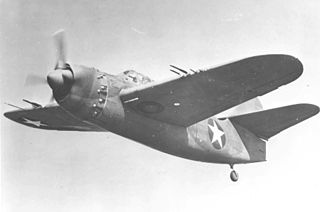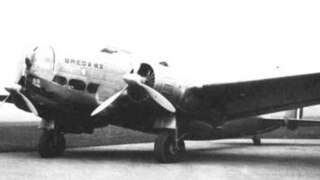
The Curtiss XF14C was an American naval fighter aircraft. It was developed by Curtiss-Wright in response to a request by the United States Navy in 1941 to produce a new shipboard high-performance fighter aircraft.

The Vought XF3U was the prototype of a two-seat, all-metal biplane fighter, built by Vought Aircraft Company of Dallas, Texas for the United States Navy.

The Vought SBU-1 Corsair was a two-seat, all-metal biplane dive bomber built by Vought Aircraft Company of Dallas, Texas for the US Navy. Its design was based upon the F3U-1 two-seat fighter that was abandoned when the Navy decided not to obtain any more two-seat fighters.

The Vultee XA-41 was originally ordered as a dive bomber. After combat experience led the Army Air Corps to believe dive-bombers were too vulnerable to enemy fighters, the contract was amended to change the role to low-level ground attack. Although the XA-41 was a potent weapons system, the design was overtaken by more advanced technology, and never entered production.

The PWS-24 was a Polish single-engine passenger aircraft for 4 passengers, built in PWS factory, used from 1933 to 1936 by LOT Polish Airlines. In spite of its limited capacity, it was the only series-built airliner of domestic design ever used by the LOT.

The XP-13 Viper was a prototype biplane fighter aircraft designed by the American company Thomas-Morse Aircraft Corporation. The airplane was delivered to the United States Army in 1929, but they did not adopt it.

The Brewster XA-32 was an American attack aircraft, a mid-wing type with an internal bomb bay. The prototype had the R-2800 engine, but it could take the intended R-4360 powerplant. After a dismal set of test results, the XA-32 did not enter production.

The Breda Ba.25 was an Italian two-seat biplane trainer designed and built by the Breda company. It was the most widely used Italian basic trainer of the 1930s.

The Bellanca CH-400 Skyrocket is a six-seat utility aircraft built in the United States in the 1930s, a continuation of the design lineage that had started with the Bellanca WB-2. Retaining the same basic airframe of the preceding CH-200 and CH-300, the CH-400 was fitted with a more powerful Pratt & Whitney Wasp radial engine.

The Bellanca 31-40 Senior Pacemaker and its derivatives were a family of a six- and eight-seat utility aircraft built in the United States in the late 1930s. They were the final revision of the original late 1920s Wright-Bellanca WB-2 design. The model numbers used by Bellanca in this period reflected the wing area and engine horsepower, each divided by ten. Like their predecessors, these were high-wing braced monoplanes with conventional tailwheel undercarriage.
The Breda-Pittoni B.P.471 was an Italian twin-engine airliner/military transport produced by Breda.

The Piaggio P.150 was a 1950s Italian two-seat trainer designed and built by Piaggio to meet an Italian Air Force requirement to replace the North American T-6.

The SIAI-Marchetti SM.102 was a 1940s Italian light transport cabin monoplane designed and built by SIAI-Marchetti.

The Eberhart XFG was an American single-seat experimental ship-borne biplane fighter aircraft developed for the United States Navy in 1927 by the Eberhart Aeroplane and Motor Company. The sole prototype was rebuilt into the XF2G with the addition of a single float and a different engine, but the aircraft was destroyed in a crash in 1928, and the type did not enter production.

The Boeing AT-15 was an American twin-engined bomber crew trainer designed and built by Boeing's Wichita Division. Only two prototypes, designated XAT-15, were built. Plans to build over 1,000 were cancelled on the United States' entry into the Second World War.

The Macchi MB.323 was an Italian single-engine basic training monoplane designed and built by Macchi. No orders were placed and only a prototype was built.

The Bach Air Yacht was a trimotor airliner produced in the United States in the 1920s. Typical of its day, it was a high-wing braced monoplane, with fixed tailwheel undercarriage. Unusual for airliners of the late 1920s, the Air Yachts were constructed almost entirely of wood with steel fittings, undercarriage, and struts. Different models were powered by varying combinations of Wright, Ryan-Siemens, Kinner, Comet, and Pratt & Whitney engines, a large engine in the nose of the aircraft, and two smaller "helpers" under the wings in nacelles supported by struts. As with so many aircraft companies of the late 1920s, the Bach Aircraft Company succumbed to the Great Depression, thus further development of the Air Yacht was abandoned after the 3-CT-9.

The Spartan C4 was an American four-seat cabin monoplane designed and built by the Spartan Aircraft Company.

The Breda Ba.82 was an Italian medium bomber prototype of the late 1930s; it was designed and built by the Breda company.
The Breda Ba.46 was a three-engined Italian bomber transport, developed from a similar but lower-powered civil transport. It was designed in Italy in the mid-1930s for colonial policing but not put into production.
This page is based on this
Wikipedia article Text is available under the
CC BY-SA 4.0 license; additional terms may apply.
Images, videos and audio are available under their respective licenses.



















